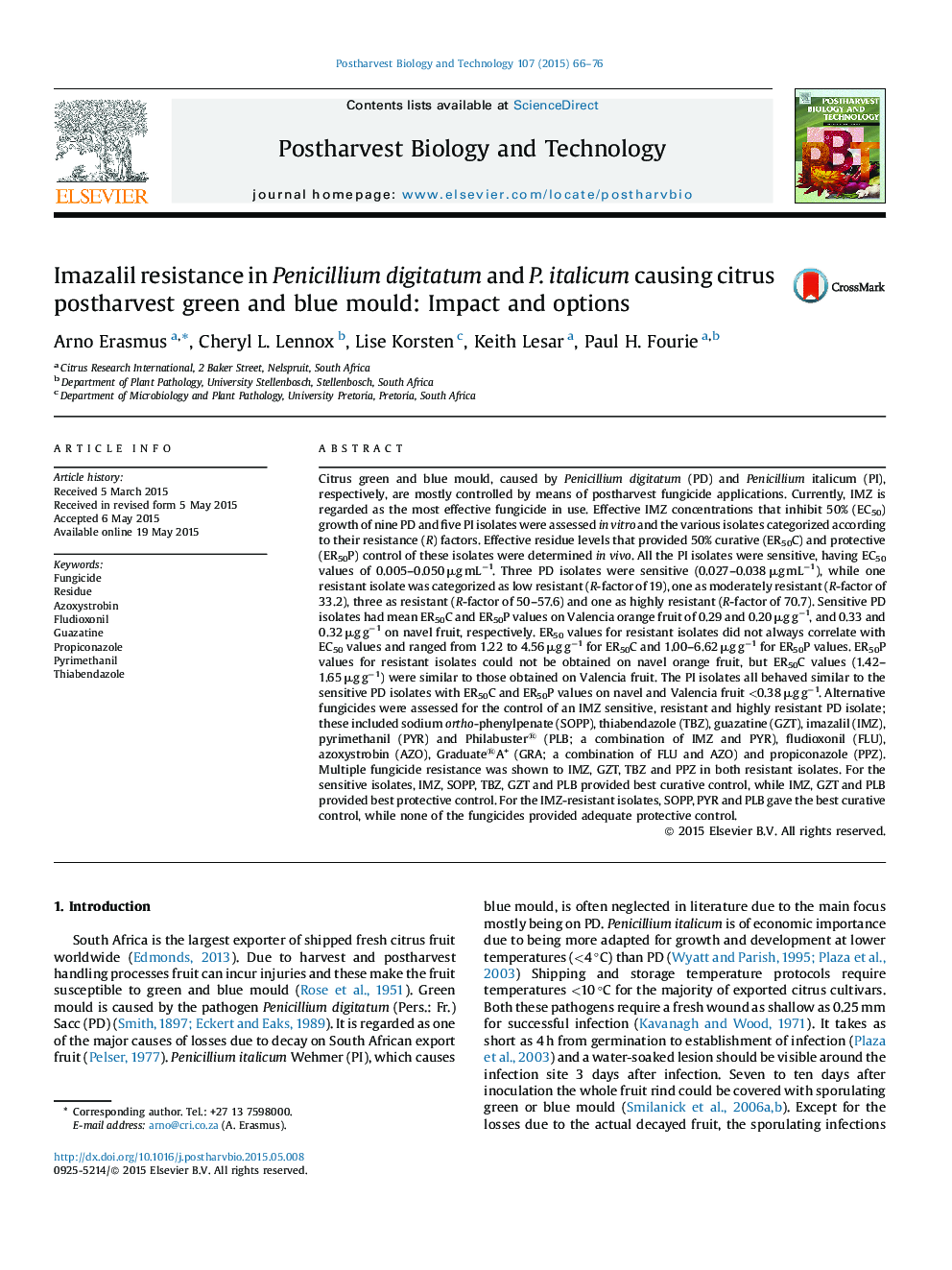| کد مقاله | کد نشریه | سال انتشار | مقاله انگلیسی | نسخه تمام متن |
|---|---|---|---|---|
| 4517990 | 1624987 | 2015 | 11 صفحه PDF | دانلود رایگان |

• The concept of effective residue levels for imazalil to control green mould is explored.
• EC50 levels of imazalil in vitro do not correlate with effective residue levels for imazalil in vivo.
• Alternative fungicides for imazalil are tested on imazalil resistant isolates.
Citrus green and blue mould, caused by Penicillium digitatum (PD) and Penicillium italicum (PI), respectively, are mostly controlled by means of postharvest fungicide applications. Currently, IMZ is regarded as the most effective fungicide in use. Effective IMZ concentrations that inhibit 50% (EC50) growth of nine PD and five PI isolates were assessed in vitro and the various isolates categorized according to their resistance (R) factors. Effective residue levels that provided 50% curative (ER50C) and protective (ER50P) control of these isolates were determined in vivo. All the PI isolates were sensitive, having EC50 values of 0.005–0.050 μg mL−1. Three PD isolates were sensitive (0.027–0.038 μg mL−1), while one resistant isolate was categorized as low resistant (R-factor of 19), one as moderately resistant (R-factor of 33.2), three as resistant (R-factor of 50–57.6) and one as highly resistant (R-factor of 70.7). Sensitive PD isolates had mean ER50C and ER50P values on Valencia orange fruit of 0.29 and 0.20 μg g−1, and 0.33 and 0.32 μg g−1 on navel fruit, respectively. ER50 values for resistant isolates did not always correlate with EC50 values and ranged from 1.22 to 4.56 μg g−1 for ER50C and 1.00–6.62 μg g−1 for ER50P values. ER50P values for resistant isolates could not be obtained on navel orange fruit, but ER50C values (1.42–1.65 μg g−1) were similar to those obtained on Valencia fruit. The PI isolates all behaved similar to the sensitive PD isolates with ER50C and ER50P values on navel and Valencia fruit <0.38 μg g−1. Alternative fungicides were assessed for the control of an IMZ sensitive, resistant and highly resistant PD isolate; these included sodium ortho-phenylpenate (SOPP), thiabendazole (TBZ), guazatine (GZT), imazalil (IMZ), pyrimethanil (PYR) and Philabuster® (PLB; a combination of IMZ and PYR), fludioxonil (FLU), azoxystrobin (AZO), Graduate®A+ (GRA; a combination of FLU and AZO) and propiconazole (PPZ). Multiple fungicide resistance was shown to IMZ, GZT, TBZ and PPZ in both resistant isolates. For the sensitive isolates, IMZ, SOPP, TBZ, GZT and PLB provided best curative control, while IMZ, GZT and PLB provided best protective control. For the IMZ-resistant isolates, SOPP, PYR and PLB gave the best curative control, while none of the fungicides provided adequate protective control.
Journal: Postharvest Biology and Technology - Volume 107, September 2015, Pages 66–76